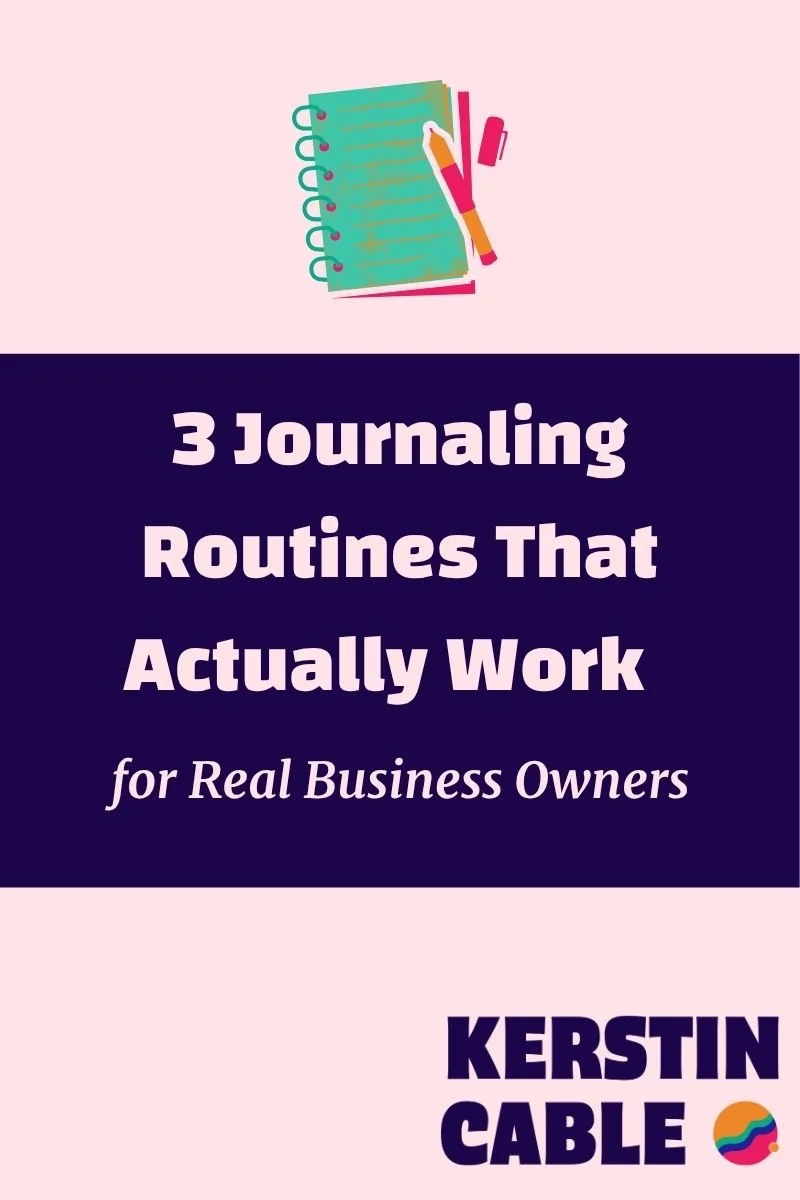3 Journaling Routines That Actually Work for Real Business Owners
Running a business is messy. If you’re juggling a half-drunk mug of coffee and about 20 minutes to your next meeting, you’re not alone.
Journaling might not seem like a serious business investment at first. But look closer and you’ll notice how many successful entrepreneurs swear by it for clear decisions, profitable ideas, and effective content.
I talked to two experienced business owners about how they use business journaling in their work, and asked them for actionable tips to help you start.
Here's what they told me:
Ruth Poundwhite: Use Journaling to Create Your Sales Content
Ruth Poundwhite* helps business owners create soulful offers and content that sells without feeling pushy.
One of the most powerful ways I use journaling in my business is to create what I call connected content - content that comes from the heart, connects with my right people, and naturally leads to sales without feeling forced.
It's especially helpful when I'm feeling "stuck", or worrying that I have nothing interesting left to say. Inevitably, I'll have a lot more to say than I thought!
Sometimes even untangling a fear or a tricky thought is enough to spark an idea that I can use in my business.
My go-to prompts are "what does my heart want me to know today?" and "what would I want my right people to know about my offer, even if they NEVER buy?"
How Journaling Attracts Clients for Ruth
Ruth’s content consistently stands out for its honesty. She trusts in herself and her audience, and that’s a big part of why people join her memberships Soulful Growth Club and Soulful Sales Society*.
If you want to write the kind of newsletters and posts that make people trust you and buy from you, Ruth’s approach is for you.
Laura Robinson: Clear Your Mind First Thing
Laura Robinson from Worditude* helps business owners bring in more sales through better marketing and copywriting.
Read my review of Laura’s Marketing Gameplan course here.
First thing in the morning, I dump out whatever is on my mind.
The sentences look like:
'I am frustrated that....';
'I don't want to do....';
'I am looking forward to....'
I don't try to resolve anything.
I don't try to fill a certain number of pages, or do it for a certain length of time. I know when I'm done.
The goal is to be better attuned to how I really feel, and what I'm really thinking rather than starting the day with 'doing.
I love how little kids will just blurt out whatever is true for them in the moment. It's hard to do that as an adult without feeling like we should be fixing something, pretending it's all OK, or striving for more.
I like being able to just be honest about my perception of how something is, or how it's affecting me, or how I'm feeling, or what I want, and not feel compelled to DO anything about it - just let it be.
Of course, I then usually do get one or two ideas I want to act on, and it's fun to go with the momentum of that.
But the goal isn't to generate a to-do list, I'm just writing a How It Is List.
How Journaling Helps Laura Run Her Business
Laura’s routine helps her make clearer decisions and stay grounded. She’s an in-demand speaker and podcast guest, and still manages to fit her business around demands from family and volunteering.
To build a business routine that’s as authentic as Laura’s, try this: Before you open your laptop or check your phone, spend five minutes writing sentence fragments about how you actually feel.
My Best Business Journaling Tip: Beat Blank Pages with Prompts & Cards
I'm Kerstin Cable, and I help business owners bring structure to their creative work through coaching and project management. I use journaling to find my way back to what matters when I'm feeling scattered.
I love working with prompts that give my journaling a focus. Some days, I might pick a new business-related prompt, on others I rely on a pre-written one that's helped me before.
I don’t practice myself to journal with any kind of consistency, and I write into whatever notebook I have handy.
And when I want a little perspective to help me come up with deeper answers, my set of cat-themed tarot cards comes to the rescue. I'm not all that woo-woo myself, but I love the way that the symbolism and archetypes of each card can connect to feelings, doubts, and decisions in my daily life.
My approach in action
If you're waiting for the perfect notebook or the right mood, you'll never start. Grab whatever's handy (even your phone) and pick one prompt to answer with a few bullet points today.
Three Ways to Start Journaling in Your Business This Week
Ready to try this for yourself? Here's exactly what to do:
1. Pick your approach
For content creation: Try Ruth's method. Next time you're stuck on what to post, open a blank page and write out answers to "What would I want my right people to know about my offer, even if they never buy?"
For mental clarity: Try Laura's method. Tomorrow morning, before you do anything else, write "I am frustrated that..." and keep going until you've emptied your mind.
For getting unstuck: Try my method. Grab whatever's handy (notebook, phone, scrap paper) and answer one business prompt.
2. Get a prompt to work with If you're not sure what to journal about, get my free Journal Spinner. It’s a randomizable database of journal prompts for entrepreneurs. Spin it once, get a prompt, and write for ten minutes.
3. Let go of the rules Just show up when you need clarity, and let the words do their work.
Clearer thinking leads to better content, better content brings in the right clients, and fewer bad decisions means less time (and money) wasted fixing things later.
Read more:
Why Journaling Is My Favourite Business Tool (and the One I Nearly Didn’t Share)
The links marked with * in this article are affiliate links, which means I may earn a small commission if you choose to purchase, at no extra cost to you.






